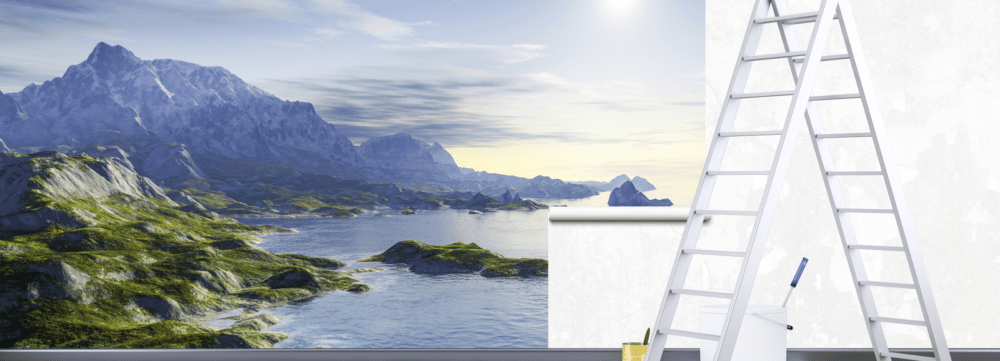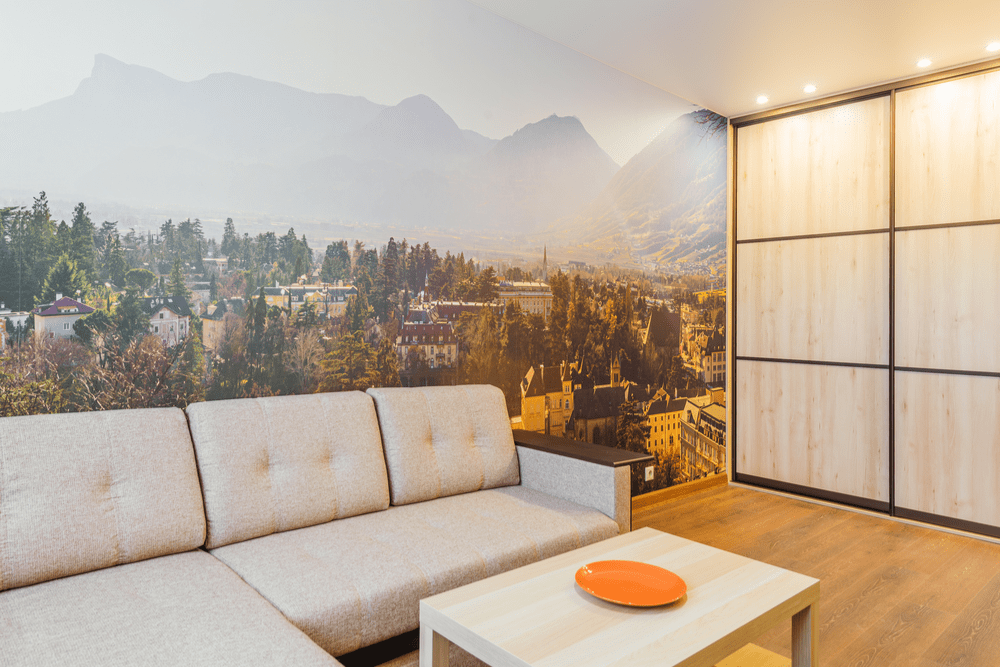Blog
Create an Engaging Environment with Supergraphics

Supergraphics are an exciting way to express the overall aesthetic of a project and create an engaging environment. These pieces are large-scale applied artwork that range in size from a few feet to the side of a building. However, to those unfamiliar with the printing process, introducing this design solution may seem intimidating and too expensive to survive value engineering. But that shouldn’t be the case.
Advancements in printing technology are increasing the number of substrates with custom image capability that are available to manufacturers, ranging from resin, vinyl or coated wallcovering, wood, metal, porcelain tile, clear film, and glass. Designers are now more able to choose a substrate that’s appropriate for a number of spaces in clinical environments and won’t break the bank. Another factor that often influences cost is the image itself, but custom graphics, commissioned photography, and even free archived photos provide options for every price range.
It’s important that designers understand what’s available today and factors to consider when specifying supergraphics for healthcare.
Printing Methods and Substrates
In general, there are three printing processes used to create supergraphics: inkjet, digital photographic, and analog. Although digital photographic methods yield the highest image quality, the end result is costlier and less durable than other methods. Analog methods, such as screen printing, tend to be more durable, but the cost varies greatly based on the quantity of printed materials to be produced.
The most commonly used process today is UV-cured inkjet printing. This method has the advantage of higher quality image capabilities with lower cost and improved durability. Most of the off-gassing occurs during the printing process, so the downtime after installation in an existing facility is reduced. Off-gassing will occur with all printing methods, but certain materials, such as resin, tend to emit stronger odors for several weeks. For a quick-turnover project, this should be considered, and materials for projects in occupied spaces should be kept off-site until the off-gassing has completed.
It’s also important to consider that healthcare environments tend to experience abuse from cart traffic and aggressive cleaning protocols. Designers should seek the owner’s input about locating certain substrates in challenging locations and test surfaces with environmental services staff. Many custom-printed substrates, like vinyl wallcovering and resin, will withstand bleach cleaning, but it’s important to know in advance. Another option is to sandwich an image between two layers of a more durable material, such as glass, if cleaning chemicals are a concern.
Answering durability concerns, several manufacturers offer custom-printed impact wall panels for a reasonable cost. Paired with impact-resistant gypsum board, these materials provide an attractive alternative to traditional wall protection and allow the design team to express the design vision without compromising performance.
Vinyl or coated wallcovering and resin can withstand intermediate wear and tear. For example, wallcovering may be used above the “impact zone” of corridors if the manufacturer offers a topcoat for increased durability. For the most challenging environments, including exterior applications, ceramic-coated steel offers a superior performance option, but the print process prevents certain colors from being as true as others, which should be factored in when selecting an image.
All printed substrates will have seams that vary based on the size limitation of the manufacturer. In some cases (wallcovering and wall protection), the seams will be almost invisible and have little impact on the design. For other substrates (metal panels, wood, or resin), the seams will be more prominent and should be identified and reviewed on shop drawings.
Selecting the Art

Finding the right image is just as critical as specifying an appropriate substrate. Some of the most common methods of procuring graphics include:
- Choose from a manufacturer’s library of images. Many companies have an extensive archive of photos available that are essentially free, so the only cost is for the substrate and installation. This may be the best option for projects with smaller budgets, but the images should be reviewed before specifying a particular manufacturer’s substrate.
- Purchase the rights to an existing image from a photographer or artist. Art consultants are a good resource for identifying existing photographs and artwork appropriate for large-scale printing. Even without an art consultant, designers can find online sources for large-scale images. Most websites will indicate a maximum print size, but for very large images, this size should be verified prior to purchase.
- Commission an artist or photographer to create an image specific to the installation. Sometimes an inexpensive alternative to purchasing an existing photo is to commission a photographer to take images of the desired landscape. Knowing the size of the installation and locations of interruptions (such as doors and windows) allows the artist to create a tailored image.
- Hire a graphic designer. A graphic designer can be a wonderful asset to a project using supergraphics. Some health systems have a branding guide that a graphic designer may use to plan custom design elements for a project.
Whichever option is used to create or procure the image, it’s important to consider the lighting that will be in the space. For example, side-lit graphics, such as an installation perpendicular to a large window, will expose imperfections in the substrate or wall behind it. Images with a medium or dark color and a busy pattern or image will be more forgiving on a less-than-perfect wall surface.
Cost Considerations
For some projects, keeping within budget can seem like the steepest hill to climb. However, additional strategic choices can be made to help bring supergraphics to life.
The most powerful way to ensure integrated artwork fits into the budget is to build art into the design documents as early as possible and identify the substrates as finishes.
If an art consultant will be engaged in the project, the design team should involve the art consultant early, as well. The images can be pulled into the artwork budget, while the substrate and installation labor remain in the construction budget. This “divide and conquer” approach reduces the budget impact to any one line item. Art consultants can also provide an allowance for the types of images that would be needed, and this information could be included in the design documents.
If the design team has an in-house graphic designer, the team can keep the images in the architectural or interior design scope without relying on subcontractors or the owner to engage a graphic designer as a separate service. Often, the graphic designer can use relatively inexpensive stock images to create a collage that can scale up to the desired size. Pursuing the option of a manufacturer’s image library also reduces costs while streamlining the process, and the team can be confident of a successful installation since the image resolution is controlled by the same party responsible for printing.
Generally speaking, the larger the supergraphic, the more expensive the cost of purchasing the image. However, when compared to purchasing original artwork of a similar size or visual impact, the cost is typically significantly less. A building owner could expect to pay tens of thousands of dollars for a 40-foot-long piece of original art, but the purchase price of an image for a similarly sized supergraphic might cost $4,000 to $7,000.
Bringing supergraphics to life
Supergraphics are a powerful addition to any project. Although much has to be considered when introducing them to a design, following the steps outlined will simplify the process. By integrating art from the outset, being strategic in selection of the graphics, and researching the performance of a substrate, it’s possible to create a solution that best fits a project’s design concept and constraints.
Carolyn Fleetwood Blake, IIDA, LEED AP, EDAC, is senior interior designer for Gresham, Smith and Partners (Jacksonville, Fla.). She can be reached at carolyn_blake@gspnet.com.
Source: Carolyn Fleetwood Blake. “Simplifying Supergraphics In Healthcare Environments.” HCD Magazine, 30 Mar. 2018, www.healthcaredesignmagazine.com/trends/simplifying-supergraphics-in-healthcare-environments/.







